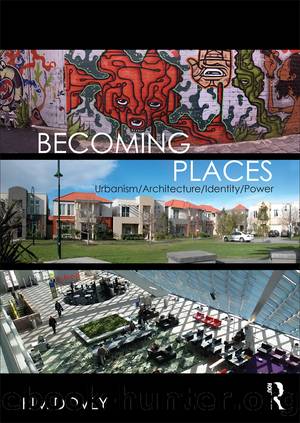Becoming Places by Dovey Kim;

Author:Dovey, Kim;
Language: eng
Format: epub
ISBN: 446777
Publisher: Taylor & Francis Group
Published: 2009-07-09T00:00:00+00:00
Sidomulyo/Kricak has relatively high levels of social capital and low symbolic capital. This has been a relatively closed place where the deeper alleys of the spatial structure are rarely traversed by outsiders. Leadership remains a male preserve while women work behind the scenes; there is a sense that any change is a threat to current practices of power. The community is subject to internal division into a range of sub-groups based on tenure, class and sexuality. Social capital is highest within the sub-groups but tensions remain between them. Building solidarity between groups and connections with a larger world are key priorities. The festival that coincided with our visit was designed in part to open up the community and to generate connections locally and globally. It was the subject of three television programmes and while there were concerns about how the place would be portrayed, the programmes were generally positive with a focus on the urban artworks. While all residents have access to television and radio, and many work across the city of Yogyakarta, there are few links to other informal settlements locally or globally.
Land tenure remains a key issue for residents, but it is more informal and deeply labyrinthine than the morphology. The informal sense of âownershipâ is everywhere ambiguous and contentious â subject to the play of politics, time, usage, materials, architectural form, rental and âleaseâ. Most residents depict themselves as âownersâ or ârentersâ. Yet there are few formal land titles and âtenantsâ have often built their houses, paying ground rent to âownersâ who in many cases hold no formal title. While the mapping of existing land tenure is crucial to the quest for tenure, such clarity can serve a variety of interests. A key dilemma is that the system is based on conflicting and contradictory systems of legitimation of ownership. Squatter housing is like a game where the rules are unclear and the primary goal is security of tenure. Ownership is widely believed to be legitimated by lengthy occupation and by the investment in âpermanentâ housing. In the absence of formal land tenure, housing plays a key role in the signification of permanence â hence the hierarchy of materials from bamboo and timber to brick, concrete and stucco.
While we have mapped the urban morphology as best we can, to map the tenure accurately is at once difficult and contentious. Difficult because of the ambiguities outlined above; there are so many categories of tenure and none of them can be regarded as âfreeholdâ. Very few residents feel at risk of eviction yet the quest for security of tenure is an important issue. The rock-crushing community with some of the least âpermanentâ housing are fearful that the âownerâ will sell the land to someone who will evict them. Others in Kricak feel relatively secure and only lack the legal âtitleâ. The Government Lands Office, however, is reluctant to grant new titles since this is seen to encourage more squatting. Pressure on the government in this regard runs the danger of triggering retaliatory evictions.
Download
This site does not store any files on its server. We only index and link to content provided by other sites. Please contact the content providers to delete copyright contents if any and email us, we'll remove relevant links or contents immediately.
Kathy Andrews Collection by Kathy Andrews(11331)
The remains of the day by Kazuo Ishiguro(8403)
Paper Towns by Green John(4805)
Spare by Prince Harry The Duke of Sussex(4792)
Industrial Automation from Scratch: A hands-on guide to using sensors, actuators, PLCs, HMIs, and SCADA to automate industrial processes by Olushola Akande(4621)
The Body: A Guide for Occupants by Bill Bryson(4590)
Be in a Treehouse by Pete Nelson(3651)
Machine Learning at Scale with H2O by Gregory Keys | David Whiting(3646)
Harry Potter and the Goblet Of Fire by J.K. Rowling(3612)
Never by Ken Follett(3537)
Goodbye Paradise(3455)
The Remains of the Day by Kazuo Ishiguro(3143)
Into Thin Air by Jon Krakauer(3132)
The Cellar by Natasha Preston(3078)
The Genius of Japanese Carpentry by Azby Brown(3041)
Fairy Tale by Stephen King(2956)
120 Days of Sodom by Marquis de Sade(2943)
Drawing Shortcuts: Developing Quick Drawing Skills Using Today's Technology by Leggitt Jim(2943)
The Man Who Died Twice by Richard Osman(2812)
